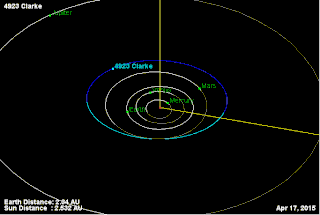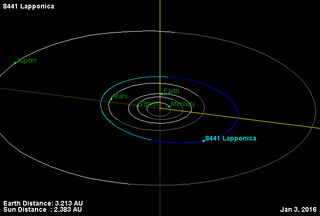Related Research Articles
1810 Epimetheus, provisional designation 4196 P-L, is a stony Florian asteroid from the inner regions of the asteroid belt, approximately 8 kilometers in diameter.

4923 Clarke, provisional designation 1981 EO27, is a stony background asteroid from the inner regions of the asteroid belt, approximately 3.5 kilometers (2.2 miles) in diameter. It was discovered on 2 March 1981, by American astronomer Schelte Bus at the Siding Spring Observatory in Australia. The spheroidal S-type asteroid has a rotation period of 3.14 hours. It was named after British science fiction writer Arthur C. Clarke. On the same night, Schelte Bus also discovered 5020 Asimov.
16879 Campai (provisional designation 1998 BH10) is a stony Witt asteroid and slow rotator from the central region of the asteroid belt, approximately 10 kilometers (6 miles) in diameter. The S-type asteroid was discovered on 24 January 1998, by Italian astronomers Andrea Boattini and Maura Tombelli at the Pistoia Mountains Astronomical Observatory in San Marcello Pistoiese, Tuscany, central Italy. It was named for Italian amateur astronomer Paolo Campai.
16765 Agnesi is a stony Eunomia asteroid from the middle region of the asteroid belt, approximately 4 kilometers in diameter. It was discovered on 16 October 1996, by Italian-American amateur astronomer Paul Comba at his private Prescott Observatory in Arizona, United States. The asteroid was named after Italian mathematician Maria Gaetana Agnesi.
12848 Agostino, provisional designation 1997 NK10, is a stony Eunomia asteroid from the central region of the asteroid belt, approximately 5 kilometers in diameter.
6470 Aldrin, provisional designation 1982 RO1, is a stony Flora asteroid from the inner regions of the asteroid belt, approximately 3 kilometers in diameter.
10502 Armaghobs ( ar-MAH-əbz), provisional designation 1987 QF6, is an eccentric, rare-type stony asteroid and Mars-crosser from the inner regions of the asteroid belt, approximately 2.6 kilometers in diameter. The asteroid was discovered on 22 August 1987, by American astronomer Eleanor Helin at the Palomar Observatory in California, United States. It was named for the Armagh Observatory in Northern Ireland.
4175 Billbaum, provisional designation 1985 GX, is a background asteroid from the central regions of the asteroid belt, approximately 9 kilometers in diameter. It was discovered on 15 April 1985, by American astronomer Edward Bowell at the Anderson Mesa Station of the Lowell Observatory near Flagstaff, Arizona. The uncommon L-type asteroid has a short rotation period of 2.73 hours and was named for American astronomer William A. Baum.
5642 Bobbywilliams, provisional designation 1990 OK1, is an eccentric, stony asteroid and Mars-crosser from the inner regions of the asteroid belt, approximately 4.7 kilometers in diameter.
3936 Elst, provisional designation 2321 T-3, is a stony Vestian asteroid from the inner regions of the asteroid belt, approximately 5 kilometers in diameter. The asteroid was discovered on 16 October 1977, by Dutch astronomer couple Ingrid and Cornelis van Houten at Leiden, on photographic plates taken by Dutch–American astronomer Tom Gehrels at Palomar Observatory in California, United States. It was named after Belgian astronomer Eric W. Elst.
23718 Horgos (provisional designation 1998 GO10) is a stony background asteroid from the central regions of the asteroid belt, approximately 2.9 kilometers in diameter. It was discovered on 2 April 1998, by Hungarian astronomers Krisztián Sárneczky and László Kiss at Konkoly's Piszkéstető Station northeast of Budapest, Hungary. The asteroid was named after the Serbian town of Horgoš.

8441 Lapponica, provisional designation 4008 T-3, is a background asteroid from the Florian region of the inner asteroid belt, approximately 4.5 kilometers in diameter. It was discovered on 16 October 1977, by Ingrid and Cornelis van Houten at Leiden, and Tom Gehrels at Palomar Observatory in California. The L-type asteroid has a rotation period of 3.27 hours. It was named for the Bar-tailed godwit, a shorebird also known by its Latin name Limosa lapponica.
4185 Phystech, provisional designation 1975 ED, is a Florian or background asteroid from the inner regions of the asteroid belt, approximately 6 kilometers in diameter. It was discovered on 4 March 1975, by Soviet astronomer Tamara Smirnova at the Crimean Astrophysical Observatory in Nauchnij, on the Crimean peninsula. The presumed S-type asteroid has a rotation period of 4.67 hours. It is named in honor of the Moscow Institute of Physics and Technology ("PhysTech") on its 50th anniversary.
5040 Rabinowitz, provisional designation 1972 RF, is a stony Phocaea asteroid from the inner regions of the asteroid belt, approximately 6 kilometers in diameter. It was discovered by Dutch–American astronomer Tom Gehrels at Palomar Observatory on 15 September 1972. Contrary to most of his discoveries, this asteroid is unrelated to the Palomar–Leiden survey and exclusively credited to Tom Gehrels.
4789 Sprattia, provisional designation 1987 UU2, is a stony background asteroid from the inner regions of the asteroid belt, approximately 4 kilometers (2.5 miles) in diameter. It was discovered on 20 October 1987, by Canadian astronomer David Balam at the Climenhaga Observatory (657) in Victoria, Canada. The S-type asteroid has a rotation period of 3.1 hours and was named after Canadian amateur astronomer Christopher E. Spratt.
12838 Adamsmith, provisional designation 1997 EL55, is a stony Koronis asteroid from the outer region of the asteroid belt, approximately 6 kilometers in diameter. The asteroid was discovered on 9 March 1997, by Belgian astronomer Eric Walter Elst at ESO's La Silla Observatory in northern Chile. It was named after Scottish philosopher and economist Adam Smith.
13058 Alfredstevens, provisional designation 1990 WN3, is a stony Vestian asteroid from the inner regions of the asteroid belt, approximately 3 kilometers in diameter. It was discovered by Belgian astronomer Eric Elst at ESO's La Silla Observatory in Northern Chile, on 19 November 1990. The asteroid was named for Belgian painter Alfred Stevens.
21501 Acevedo (provisional designation 1998 KC8) is a stony Florian asteroid from the inner regions of the asteroid belt, approximately 2.4 kilometers in diameter.
12564 Ikeller, provisional designation 1998 SO49, is a stony Koronian asteroid from the outer region of the asteroid belt, approximately 5 kilometers in diameter.
14436 Morishita, provisional designation 1992 FC2, is a stony background asteroid and exceptionally slow rotator from the middle region of the asteroid belt, approximately 5 kilometers in diameter.
References
- 1 2 3 4 "JPL Small-Body Database Browser: 49777 Cappi (1999 XS)" (2016-08-27 last obs.). Jet Propulsion Laboratory . Retrieved 28 June 2017.
- 1 2 Schmadel, Lutz D. (2006). "(49777) Cappi [2.36, 0.07, 4.5]". Dictionary of Minor Planet Names – (49777) Cappi, Addendum to Fifth Edition: 2003–2005. Springer Berlin Heidelberg. p. 215. doi:10.1007/978-3-540-34361-5_2544. ISBN 978-3-540-34360-8.
- 1 2 3 4 5 6 7 "LCDB Data for (49777) Cappi". Asteroid Lightcurve Database (LCDB). Retrieved 28 April 2016.
- 1 2 "Asteroid 49777 Cappi – Proper Elements". AstDyS-2, Asteroids – Dynamic Site. Retrieved 29 October 2019.
- 1 2 3 Waszczak, Adam; Chang, Chan-Kao; Ofek, Eran O.; Laher, Russ; Masci, Frank; Levitan, David; et al. (September 2015). "Asteroid Light Curves from the Palomar Transient Factory Survey: Rotation Periods and Phase Functions from Sparse Photometry". The Astronomical Journal. 150 (3): 35. arXiv: 1504.04041 . Bibcode:2015AJ....150...75W. doi:10.1088/0004-6256/150/3/75 . Retrieved 28 April 2016.
- ↑ Veres, Peter; Jedicke, Robert; Fitzsimmons, Alan; Denneau, Larry; Granvik, Mikael; Bolin, Bryce; et al. (November 2015). "Absolute magnitudes and slope parameters for 250,000 asteroids observed by Pan-STARRS PS1 - Preliminary results". Icarus. 261: 34–47. arXiv: 1506.00762 . Bibcode:2015Icar..261...34V. doi:10.1016/j.icarus.2015.08.007 . Retrieved 28 April 2016.
- 1 2 3 "49777 Cappi (1999 XS)". Minor Planet Center. Retrieved 28 April 2016.
- ↑ "MPC/MPO/MPS Archive". Minor Planet Center. Retrieved 28 April 2016.